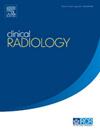基于磁共振成像(MRI)的深度学习放射组学模型预测脑转移手术切除后肺癌患者的无复发生存期
IF 2.1
3区 医学
Q2 RADIOLOGY, NUCLEAR MEDICINE & MEDICAL IMAGING
引用次数: 0
摘要
目的开发并验证基于磁共振成像(MRI)的深度学习放射组学模型(DLRM),以预测肺癌脑转移瘤(BrMs)手术切除后的无复发生存期(RFS)。材料与方法回顾性分析5个中心215例经手术病理证实的肺癌brm患者,167例患者被分配到培训组,48例患者被分配到外部测试组。所有患者都接受了定期随访的脑部核磁共振成像。分别使用单因素和多因素Cox回归建立预测RFS的临床和形态学MRI模型。使用最小绝对收缩和选择算子(LASSO)方法分别从BrMs预处理的MR图像构建手工和深度学习(DL)签名。基于多变量Cox回归系数,通过整合临床和形态学MRI预测因子、手工和DL特征,建立了DLRM。采用Harrell c指数、受试者工作特征曲线下面积(AUC)和Kaplan-Meier生存分析来评价模型的性能。结果DLRM在预测肺癌BrMs切除术后患者的RFS和6 ~ 18个月颅内复发方面表现满意,训练集的c -指数为0.79,auc为0.84 ~ 0.90,外部测试集的c -指数为0.74,auc为0.71 ~ 0.85。DLRM在预测RFS方面优于临床模型、形态学MRI模型、手工签名、DL签名和临床-形态学MRI模型(P <;0.05)。DLRM成功地将患者分为颅内复发高危组和低危组(P <;0.001)。结论基于mri的DLRM可以预测肺癌肿瘤切除术后患者的RFS。本文章由计算机程序翻译,如有差异,请以英文原文为准。
A magnetic resonance imaging (MRI)-based deep learning radiomics model predicts recurrence-free survival in lung cancer patients after surgical resection of brain metastases
Aim
To develop and validate a magnetic resonance imaging (MRI)-based deep learning radiomics model (DLRM) to predict recurrence-free survival (RFS) in lung cancer patients after surgical resection of brain metastases (BrMs).
Materials and Methods
A total of 215 lung cancer patients with BrMs confirmed by surgical pathology were retrospectively included in five centres, 167 patients were assigned to the training cohort, and 48 to the external test cohort. All patients underwent regular follow-up brain MRIs. Clinical and morphological MRI models for predicting RFS were built using univariate and multivariate Cox regressions, respectively. Handcrafted and deep learning (DL) signatures were constructed from BrMs pretreatment MR images using the least absolute shrinkage and selection operator (LASSO) method, respectively. A DLRM was established by integrating the clinical and morphological MRI predictors, handcrafted and DL signatures based on the multivariate Cox regression coefficients. The Harrell C-index, area under the receiver operating characteristic curve (AUC), and Kaplan–Meier's survival analysis were used to evaluate model performance.
Results
The DLRM showed satisfactory performance in predicting RFS and 6- to 18-month intracranial recurrence in lung cancer patients after BrMs resection, achieving a C-index of 0.79 and AUCs of 0.84–0.90 in the training set and a C-index of 0.74 and AUCs of 0.71–0.85 in the external test set. The DLRM outperformed the clinical model, morphological MRI model, handcrafted signature, DL signature, and clinical-morphological MRI model in predicting RFS (P < 0.05). The DLRM successfully classified patients into high-risk and low-risk intracranial recurrence groups (P < 0.001).
Conclusion
This MRI-based DLRM could predict RFS in lung cancer patients after surgical resection of BrMs.
求助全文
通过发布文献求助,成功后即可免费获取论文全文。
去求助
来源期刊

Clinical radiology
医学-核医学
CiteScore
4.70
自引率
3.80%
发文量
528
审稿时长
76 days
期刊介绍:
Clinical Radiology is published by Elsevier on behalf of The Royal College of Radiologists. Clinical Radiology is an International Journal bringing you original research, editorials and review articles on all aspects of diagnostic imaging, including:
• Computed tomography
• Magnetic resonance imaging
• Ultrasonography
• Digital radiology
• Interventional radiology
• Radiography
• Nuclear medicine
Papers on radiological protection, quality assurance, audit in radiology and matters relating to radiological training and education are also included. In addition, each issue contains correspondence, book reviews and notices of forthcoming events.
 求助内容:
求助内容: 应助结果提醒方式:
应助结果提醒方式:


